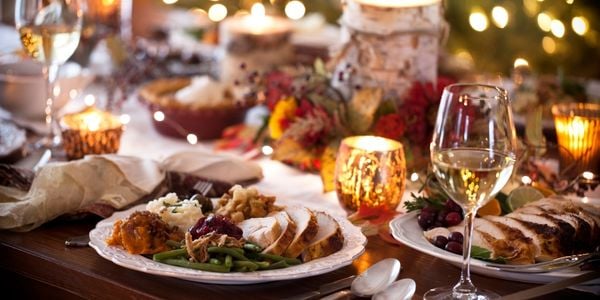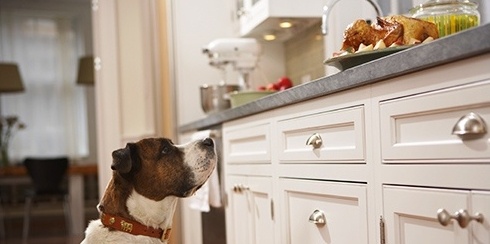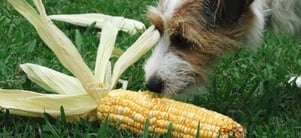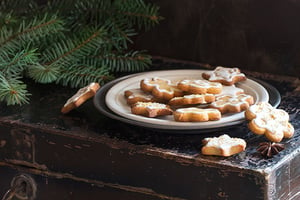 Thanksgiving is a wonderful holiday and a great time to join together with friends and family — be they two-legged or four (or even three, lest we forget about our "tripawd" dogs and cats).
Thanksgiving is a wonderful holiday and a great time to join together with friends and family — be they two-legged or four (or even three, lest we forget about our "tripawd" dogs and cats).
As you’re preparing your Thanksgiving plans, it’s important to be aware of the common pet hazards associated with this day of friends, family, feasting, fun, and football.
If you’re not, you could end up spending your Thanksgiving in the animal emergency room.
Thanksgiving Foods to Avoid
- Turkey
- Stuffing
- Mashed potatoes and candied yams
- Corn on the cob
- Yeast bread and rolls
- Food prep materials and trash
To have a pet-safer Thanksgiving, keep in mind the following information and advice
As they can be for people, the holidays can be disruptive and stressful for cats and dogs, too. From houseguests making an extended stay to the chaos of the actual day, the stress can cause anxiety and significant problems in our furry friends. Not to mention the food that's being prepared and served all day ... it can be a smorgasbord of potential pet problems!
Food preparation materials and trash
You can't have a Thanksgiving meal without the countless hours spent in the kitchen! It might surprise you to realize that much of what you're using during those countless hours to prepare and serve the meal can be enticing to your pets and wreak havoc for them ... and for your celebration. Here are some common culprits below:
Aluminum foil and plastic wrap: When covered in food scraps and drippings, such items become a hard-to-resist treat for your wayward pets. If ingested, these can cause inflammation and/or obstruction of your pet’s digestive tract.
Cooking twine: Often used to close the body cavity of the turkey to keep the stuffing in during cooking, cooking twine poses a very significant danger to your pets, particularly cats. If they get partially stuck within their digestive tract, such linear foreign bodies can cause serious damage to the wall of the intestine, resulting in the leakage of intestinal contents into the abdominal cavity, requiring emergency medical care and surgery, typically followed by a prolonged hospital stay.
Trash cans and compost bins: Kitchen trash cans and compost pails are a dietary indiscretion treasure trove for mischievous dogs and cats. From turkey bones and giblets to discarded coffee grounds and filters, trash cans and compost bins contain many things that can cause your pet significant health problems. Be sure to truly secure these hazards by making sure that they are closed tightly and kept safely behind closed closet or cabinet doors. And it's not too late to teach an old dog (or young) new tricks! Check out our six important behavior training tips for dogs (including "Leave It" and "Drop It").
Pet hazards commonly found on the Thanksgiving table:
Many of the foods we eat safely throughout the year can cause digestive upset, obstruction, or toxicity to our pets. At Thanksgiving, several of them are all in one place at the same time — a pet emergency ‘perfect storm’ of sorts. From the holiday bird or ham to many of the common side dishes, danger-galore lurks on the Thanksgiving table for your cats and dogs.
Turkey
Sure, a small amount of the Thanksgiving bird may make a safe treat for your pets (see our list of Pet-Safe Thanksgiving Treats below). Push it, though, and you could be spending your evening and the next day cleaning vomit and diarrhea out of your carpet and nursing a very sick (and in pain) dog.
A tablespoon of white bird meat is often safe enough to give your pets for a little holiday treat BUT giving them too much or giving them any quantity of the skin, seasonings, drippings, gravy, or bones can cause inflammation of their digestive tract resulting in vomiting, diarrhea, lack of appetite, abdominal pain, and dehydration. Such inflammation (called ‘gastroenteritis’ when it affects the stomach and intestines and ‘pancreatitis’ when it affects the pancreas) often results in an unplanned trip to the veterinarian. Many cases of gastroenteritis and pancreatitis result in a hospital stay for your pet, and some cases can even prove fatal. Treatment for gastroenteritis/pancreatitis often runs in the few hundred to couple thousand-dollar range.
The carcass and bones of the turkey pose an additional danger to your pet should they chew or eat them. Turkey bones are brittle and splinter easily, with the resulting sharp points able to puncture your pet’s esophagus, stomach, or intestines. Puncture in any of these structures will result in a very sick, very painful pet and require an expensive surgical procedure. Don’t allow your pets to steal the carcass, and certainly don’t intentionally give them such ‘treats.’

Speaking about the turkey… do you remember the turkey-stealing Bumpus dogs in A Christmas Story? (If not, you've got to check it out). Ever notice that you don’t see them again in the movie after that incident? It’s likely because they’re deathly ill from digestive tract inflammation or puncture, or maybe even Salmonella poisoning if that turkey was undercooked. Poor dogs! Great movie! But, if you want to avoid that scene for your dogs, be careful what you leave on the counter, AND check out our tips on how to train your dog not to counter surf.
The same warnings above also go for any other type of bird you might enjoy — be it chicken, duck, or all of the above ... turducken is yummy! And if it's ham you’re serving, you still need to be careful — because of the bone and the (often high) salt content.
Stuffing
Many Thanksgiving stuffings contain onions and/or garlic. In small quantities, these vegetables aren’t likely to cause too big a problem for your cats and dogs, but in larger quantities, or if your pet already has a low red blood cell count (anemia) or dysfunctional red blood cells, ingestion of onions or garlic can prove both debilitating and expensive.
Additionally, as more people are getting creative with what they stuff inside their holiday bird, an increasing number of stuffings now contain raisins, currants, or (maybe even) grapes. What you might not be aware of, though, is that grapes, raisins, and currants can be highly toxic to dog kidneys, even in small quantities. Not every dog is affected, and the exact toxic substance is still unknown. Given that the resulting acute kidney failure can be fatal and expensive to treat (well into the several thousands of dollars), it’s best just to avoid this one at all costs. Note that this toxicity may affect cats, too.
Mashed potatoes and candied yams
Both of these traditional holiday sides often contain significant quantities of butter and other fats, making them irresistible to both people and pets. While an overindulgence on your part will likely lead to a post-meal unbuttoning of the pants and a nap, such an indiscretion by your dog can lead to a post-meal bout of pancreatitis. As already discussed, pancreatitis can range in severity from mild and uncomfortable to severe and fatal, with several ‘shades of grey’ (and associated outcomes and costs) in between. Certain dogs have an increased risk of developing pancreatitis, and some of these risk factors also increase the chances that their bout of pancreatic inflammation will be more severe too (also read ‘more painful, longer hospital stay, increased risk of death, and more costly’).
Generally speaking, miniature schnauzers and Silky and Yorkshire terriers are at increased risk of pancreatitis. As is any dog that is obese or has certain endocrine disorders (namely diabetes, Cushing’s disease, or hypothyroidism).
In addition to the risks associated with the fats in these side dishes, it is also important to be aware that some people use garlic in their mashed potatoes, and some add raisins to their candied yams. Both of these, as previously discussed, can prove dangerous to your pets.
Corn on the cob
The primary danger that corn on the cob presents to dogs is when they eat the cob itself. Many dogs will swallow large chunks of the cob, which will wind up lodging in and obstructing their intestines. And though this often makes for a cool-looking x-ray for we veterinarians to look at, it also requires expensive surgery to resolve. So I want to help you avoid it. Save yourself a few thousand dollars and your dog the time in the hospital and on the surgery table by not intentionally giving your dog corn cobs and not giving them the opportunity to steal corn cobs out of the trash or compost either.
Yeast bread and rolls
Here it isn’t so much the finished product that’s a problem for pets, but rather the rising dough prior to baking. When yeast and starch come together in a warm environment the yeast ferment the sugars in the starch, giving off carbon dioxide gas and alcohol. (It’s this carbon dioxide gas that causes yeast bread dough to ‘rise.’ It's also what gives beer and sparkling wine their bubbles.) The yeast doesn’t care if that warm environment is in a covered bowl, proofing oven, or your dog’s stomach. It’s all the same to them, but definitely not to your dog!
When the fermentation occurs in your dog’s stomach, the resulting alcohol gets into their bloodstream leading to severe metabolic and neurologic abnormalities (alcohol poisoning), and the carbon dioxide distends their stomach leading to pain and a decreased return of blood to their heart (shock). Either of these can prove fatal. Add the potential for the rising mass of bread dough to cause an obstruction preventing the passage of itself and other things from the stomach into the intestine, and you’ve got an emergency that you definitely want to try to take simple steps to prevent.
Yeast bread dough ingestion requires an emergency trip to the veterinarian, most often leading to a hospital stay and occasionally resulting in a surgery. If you bake your own bread or rolls, or anything else with yeast, be sure to keep it well out of your dog’s reach while it’s rising. This emergency most often happens when people leave dough out to rise on the counter overnight - don’t make this mistake. Let your dough rise in a turned-off conventional or microwave oven or on a high shelf, where it will truly be safely out of reach for your dogs.
If your dog does ingest yeast-containing dough, immediately try to get them to drink ice water and then get them to the veterinarian as quickly as possible. The ice water will drop the temperature within their stomach, slowing down or inactivating the yeast and halting the fermentation process. (Don’t worry; the ice water doesn’t cause Bloat!)
Desserts
A Thanksgiving meal just isn't complete until the pies, cakes, and cookies are all gone. Right! Well, while you and your houseguests are likely aware of the dangers that chocolate poses to cats and dogs, I would venture to guess that many of the people around your holiday table likely aren't aware of what xylitol is, let alone the fact that xylitol is VERY dangerous to dogs. With more and more people eating "all-natural" and trying to decrease their sugar intake, xylitol is becoming increasingly common in both store-bought and home-baked goodies. Xylitol is a natural sweetener that is becoming an increasingly common sugar replacer; it can quickly plummet a dog's blood sugar and even destroy their liver. If you have or love dogs, please take a moment to learn about the very real danger that xylitol poses to dogs.
Pet-safer treats during the holidays
Treating pets safely can be as simple as some extra snuggle time, an extra long walk, a freshly cleaned-out litter box, or a nice new bed to sleep in. But if you’d like to give them a little extra food snack on this day, here are some pet-safer treats to do so with.
- Pumpkin puree: not the pie filling, just the plain canned pumpkin
- Green beans: raw or cooked (preferably steamed or boiled)
- Carrots: raw or cooked (preferably steamed or boiled)
- Apple slices: not the ones from the middle of the pie, and never whole
- Turkey: white meat in small quantities and without the skin, seasonings, bones, or gravy
- Their own kibble: put some in a new interactive toy to satisfy both their belly and their boredom
Thanksgiving should be a wonderful day spent with friends and family reflecting on all that we have to be thankful for in this world, not one spent in the waiting room of the local pet emergency hospital. With prior awareness and simple precautions you’re more likely to have the former and avoid the latter. For more pet safety tips check out this article about pet hazards because of houseguests.
From all of us at Preventive Vet — wishing you and yours a happy, healthy, and safe Thanksgiving. Gobble gobble!




